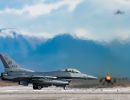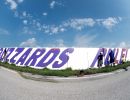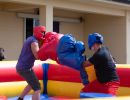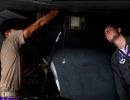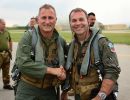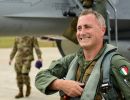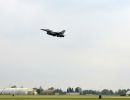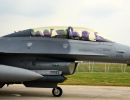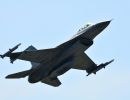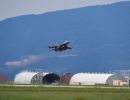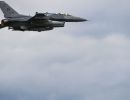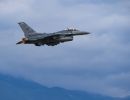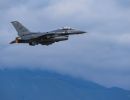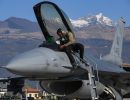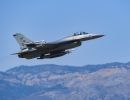Allied Force Debrief
Hehs, Eric. Code One: Oct 1999. Vol. 14 No. 4: Pg 18-29.

Air Commodore J. Thomas Bakker
Deputy Chief of Operations
Royal Netherlands Air Force
RNLAF Headquarters, The Hague
Bakker was the national representative for the Netherlands during Operation ALLIED FORCE. He was stationed at the Combined Air Operations Center in Vicenza, Italy. "When our nation contributes aircraft and shifts authority to a NATO commander, these military assets are still governed by political constraints," Bakker explains. "Our political leaders want to ensure that our country's aircraft are used as intended by parliament. The minister of defense appointed a senior national representative for this purpose." In this position, Bakker communicated daily with the Joint Force Air Component Commander, Lt. Gen. Michael C. Short.
RNLAF Participation
We had our own tankers. We provided transport aircraft. We supported a parallel operation, Allied Harbor, a human relief operation in Albania. We had helicopters positioned in Macedonia and later in Albania. They are still there. We provided Apache helicopters for SFOR in Bosnia. The current helicopter detachment in the Balkans is larger than our current fighter contribution, which is down to four aircraft at Amendola AB, Italy, where we work with the Belgian Air Force and maintain a basic capability of eight aircraft. These F-16s are maintaining a ground alert status and flying air support missions. We can boost this contingent to thirty-plus aircraft in two or three days.
RNLAF Use Of Mid-Life Update F-16
The F-16 update was introduced at the right time for us. We had a state-of-the-art fighter when the conflict arose. Together with the F-15, the F-16 MLU is capable of interrogating aircraft. F-16 MLU pilots can also communicate with each other via a data modem. They carry AMRAAM missiles and have a full night capability. Next to the United States, few countries could offer these capabilities. Once the CAOC understood what we could do with MLU aircraft, they started using us more. We made the argument that, in some ways, the F-16 MLU is better than a Block 40 or 50 F-16. This understanding takes some time to set in.
Just because a country operates the F-16 MLU, however, doesn’t mean that it can use it properly. So training is another issue. We participate in Red Flag and frequently train with USAF in Europe. So, we had to convince decision makers of our level of proficiency with these advanced systems as well as convince them of the capability of the systems themselves.
Missions Flown By The RNLAF
We flew everything apart from SEAD missions. We regularly flew air defense and combat air patrols. We were the only non-US air force used at the beginning of the conflict in sweep and escort missions. We downed the MiG-29 in a sweep mission. Pilots need IFF and a good radar to perform sweep missions. In my estimation, our radar performs better than the APG-68. We can sort targets more easily because we have better overall situation awareness. Furthermore, our modem allows us to feed information directly to other USAF F-16s.
The more difficult targets required LANTIRN; we acquired five targeting pods on short notice for these missions. Looking back, that was the best example of how we used creativity and showed our capability and expertise. We brought RNLAF pilots with LANTIRN experience from CONUS. We converted them from Block 40 F-16s to the MLU F-16. We flew experimental software on these missions. [The RNLAF had to get approval for this.] The conversion worked out very well. In less than four weeks, we were flying complex LANTIRN missions. I think our performance in the operation earned us a lot of respect. We rushed our own LANTIRN capability because air forces could not participate in important missions unless they had a precision-guided munitions capability. The French have target designators as do the Spanish and the British. We are often viewed as the biggest of the small European countries. Every once and a while, it is nice to be the smallest of the big countries.
 |
Col Jeffrey Eberhart31st FW Ops Group Commander All USAF units at Aviano AB fell under Eberhart's command during Allied Force. "The other services and other countries here did not fall under my command if you follow the wiring diagrams," he says. "But for all practical purposes, the Spanish, Canadians, British, and Portuguese units deployed here during Allied Force became one seamless organization in terms of command and control. We don't treat the international units and differently than we do our USAF units. We have always had a good working relationship with these other countries and with the other services." Eberhart flew fourteen missions in Block 40 F-16s during the conflict. "I worked and flew mostly at night," he says. "I did fly several day sorties because I wanted to get into every mission, during the day and at night, to see the whole picture." |
Misconceptions
CNN made it look too easy as if we stare at a TV screen, place a set of crosshairs on a target, and then the target blows up. The evening news rarely shows SAMs tracking our jets and pilots getting shot at by antiaircraft artillery. Nor can they show all the planning and expertise needed to get the airplanes to the right spot at the right time. The biggest misconception was that Allied Force was a computer war and that it was easy.
The CNN Factor
The media is a fact of life. If ninety-nine percent of the bombs went where they were supposed to go, the news reports focus on the fraction of a percentage that miss their targets. Of course a lot of the news coverage came at the courtesy of Mr. Milosevic dragging reporters around to show them damage. Some of these media events involved actual misses. Others were likely staged affairs. In either case, the coverage affected our operations. We spent a fair amount of time investigating reports that appeared on CNN.
The lion’s share of the bombs was on target. Misses were almost always the result of a munitions failure or a target was blanked out by the explosion of another bomb or by a cloud. We had very few instances of pilot error, where a pilot dropped a bomb on the wrong place. But bombs rarely dropped in the wrong place for whatever reason.
The SAM Threat
The Serbs launched over 500 radar-guided SAMs during the war. The threat was active and unpredictable. We could fly to one place one night and we would see a lot of SAMs and AAA. The next night, we might not see one shot in the same area. If they turned on a radar or fired a SAM, it moved immediately thereafter—whether it was an SA-3 or an SA-6. The AAA was all over the place. We never did figure out the Serbs SAM doctrine, or if they even followed a doctrine. Clear to the end of the war, they had enough radar-guided SAMs around to shoot at us in any part of the country.
Working With Block 50 F-16s
The HARM carried by the Block 50 in the SEAD mission [suppression of enemy air defense] doesn’t have a big warhead. A HARM has to guide on the radar signal. Most SAM operators that are smart are not going to leave that radar on very long. That’s good for us: If that radar isn’t on, we’re not going to get hit. But the HARM is not going to guide on the site either. Even if a HARM hits a site, it may blow up a radar dish or put a couple of holes in it. In most cases, though, it won’t put a SAM site down for the count. On the other hand, a 2,000-pound bomb will and so will a Maverick. Block 50 pilots perform hunter-killer, or DEAD [destruction of enemy air defense, pronounced deed], missions themselves with the Maverick missiles. They can’t drop laser-guided bombs.
We used the datalink capability between the Block 40 and the Block 50 F-16 to address this issue. The HTS pod on the Block 50 locates a SAM. Those coordinates are then transmitted to a Block 40, which carries a laser-guided bomb. The Block 40 would then target and destroy the SAM site. We had some success with this tactic, but we never used it much because we had competing priorities that took precedence. We did have one big success when we teamed Block 40 and Block 50 on an early warning radar in Montenegro. This particular early warning radar was a problem through most of the war. When we got a tip where it was located, we had a Block 50 F-16 go in and shoot a HARM at it. The HARM hit real close and did some damage. Then a pilot in a Block 40 used his targeting pod to drop an LGB on the site to completely destroy it.
Defining Success
Our wing flew 9,000 sorties and 40,000 hours. Aside from having a couple of pilots go down in the war zone, we didn’t scratch anybody or anything and we put a hell of a lot of bombs where they were supposed to go. So I would classify the operation as a success. Launching and recovering a mass of aircraft into the middle of the Adriatic every night with everybody going to their tankers and getting to the right place at the right time and no one getting in anyone else’s way is quite an accomplishment.
 |
Lt. Col. Steven SchraderCommander Schrader flew thirty-nine missions during Allied Force. "We hit everything from targets two miles south of the northern border of Serbia to targets two miles north of the southern border to the eastern border and the way to the other side," he says. "Both Aviano squadrons spent a lot of time flying forward air controller missions over Kosovo. I flew nights at the beginning of the war. I got home about six in the morning and took the kids to the bus stop for school. I would go back home and go to sleep and get up to see my wife in the evening before I left for work. We weren't losing airplanes, and this kept the home life from getting weird. The stress level came down after a while." |
Memorable Mission
We were flying a DEAD mission at night. We went to a SAM site that had been active for a few days. We dropped bombs on what turned out to be [infrared] shadows of vehicles that had just left. Afterwards, we waited for further tasking. While waiting, I watched between ten and twenty SAMs fly into the air. With the night vision goggles, we can see everything that comes off the ground. That light show went on for about ten minutes from three different sites. We had antiaircraft artillery firing at us from down below. We left the area and flew over an airfield on the way out. I saw a MiG-21 out in the open and targeted it with a laser-guided bomb. That was the first airplane this squadron hit on the ground. Everyone wanted to see my video when I got back.
Getting Shot At By SAMS
The best way I can describe the feeling of being shot at by a SAM is uncomfortable. No one got excited enough to scream on the radio or even talk real fast. We had to watch the airborne SAMs to make sure they were moving on the canopy, which meant they were not coming at us. By the time we figured out one was going away from us, the Serbs would often launch another one. These situations were made more difficult when more than one site was shooting SAMs. The SAMs fly for a good thirty or forty seconds, which seems like forever. We never became complacent, but we gained experience.
Target Identification
Working moving targets in Kosovo was difficult. Differentiating a military vehicle from a civilian vehicle is very difficult. We may have been sixty percent sure a target was a military vehicle, but we could not drop unless we were certain. Pilots needed lots of patience. Going back three times and destroying ten targets was better than destroying ten targets on one mission and losing an airplane.
Multiple Bomb Release
One of our standard night tactics is to release precision guided munitions from multiple airplanes and get them to hit simultaneously. This tactic prevents the explosion from one bomb from interfering with the laser targeting of the others. We had employed this tactic with two ships at night and during the day. Allied Force was the first time we used four aircraft to release multiple weapons to hit multiple targets within five hundred feet or less at night. Without these tactics, which require NVGs, aircraft would need ten or fifteen minutes to go through the same target area. And they would experience more misses because the smoke would obscure bombs from the next aircraft. The aircraft would also be exposed to SAM threats for a longer period.
Unmanned Vehicles
We will see more unmanned vehicles, like the Predator. These assets can find targets really well, and they have good station times. On one of my missions, a Predator found some tanks near a train station right in the middle of a small town. The controller started talking me onto the target. I didn’t know he was flying a Predator. I thought he was working off a still photo until he called “shack,” which means direct hit, after I dropped my first bomb. So I knew he wasn’t working off a photo. Without the detailed information transmitted to me from the Predator, I could not have dropped on the tank. That night we blew up all kinds of military vehicles and a warehouse the Serbs were using to repair these vehicles.
F-16 Upgrades
I’d like to have a laser spot tracker. Instead of going in somewhere and having someone talk me onto a target, target coordinates could be transmitted to my aircraft and displayed on my head-up display. The A-10 has a laser spot tracker. We don’t, and it’s a mistake to leave that capability off the targeting pod. I guarantee that every other Viper pilot in the world is dying for an integrated NVIS modification like ours. A real datalink, such as Link 16, would be useful for giving us the whole picture—the ability to receive an image from the ground or from another aircraft. Finding the target is still the weakest link. Weather is a factor, but it will become less of a factor with GPS-guided weapons. GPS in our F-16s gives us a huge advantage. The thrust-to-weight ratio of the F-16 gave us an advantage over other aircraft. Our low fuel consumption was another advantage.
 |
Wayne McGartlinTechnical Representative McGartlin has been at Aviano since 1995. He and Paul Fite, another Lockheed Martin technical representative who came in with the Spangdahlem Block 50 F-16s, covered the clock in two twelve-hour shifts during the operation. Company representatives, like McGartlin and Fite, have a direct engineering link to the F-16 systems. "We can get with the engineer responsible for a particular system on short notice if necessary," says McGartlin. "During the operation, we got engineering responses back in a matter of hours. We had early copies of technical orders. For example, we had advance documents for the ALE-50 pylons." |
F-16s Everywhere
The pace here was considerably faster during Allied Force. We worked harder than normal because of all the extra flight hours the aircraft were accumulating. Flight duration was another issue. Flights normally last about two hours. During the war, the duration shot up to over seven hours. We also had more aircraft to deal with. Aside from the F-16s from Spangdahlem, Shaw AFB [South Carolina] sent twenty-five and Portugal had another half-dozen here. We let each unit know that we were available to help them. In all, we had about fifty more F-16s here than normal. Every serviceable airplane was committed to the schedule. Every piece of ground was used to park airplanes. People had to be extremely careful with all the live ordnance on the ramp as well.
Duration Effects
We saw some system failures at two-plus hours. Some radar write-ups occurred on missions that exceeded five hours. Trying to troubleshoot a problem that occurs that far into a flight is difficult. We may let an aircraft system run for two hours to check it. We had to develop new procedures to deal with problems resulting from the longer sorties. For example, we developed a checklist that addressed several malfunctions we experienced with the internal data modem. The rainy weather put a lot of extra stress on the airplane as well. Pilots were also bringing back more ordnance and landing heavier than normal, which causes additional stress. We were going through phase times much faster. To meet those increased demands, we had to augment the crews who perform phase inspections. We saw more NVIS failures than normal because of the long night sorties. But we never had to cannibalize an aircraft for these parts. Overall, the airplane performed extremely well. What people hear about the F-16 is true: the more the pilots fly it, the better it performs.
Latest Toys At Aviano
The pylon for the towed decoy system was installed by Raytheon and Lockheed Martin in August 1995 in a QRC [quick reaction capability] effort. In December 1995, Lockheed Martin took over sole support for the unit. The company does the training, provides the support equipment, and makes all the necessary modifications. Sure Strike was first installed in October 1995. All aircraft were modified by that December. Aviano flies the only Block 40 F-16s in the world with this internal data modem. A QRC team from Lockheed Martin began installing NVIS in fall 1997. Gold Strike, which allows images to be transmitted via the data modem, will likely be a QRC effort soon.
Aviano F-16s often come back with heavier than normal loads because of the ordnance they carry on combat-rated missions. To deal with this, we put Block 50-style brakes on the Aviano F-16s last year. The brakes and wheels are bigger than those on the Block 40, so they dissipate heat faster. The change reduced brake write-ups significantly. We get all the latest toys here. We get exposed to new technologies and new equipment and that adds more enjoyment and excitement to the job. I really feel like I am accomplishing something, helping the aircraft mature. I get a lot of satisfaction when I see these new systems making a difference.
 |
Lt. Col. David GoldfeinCommander Goldfein flew thirty-four missions in Block 40 F-16s during Allied Force. "The F-16 has been called the workhorse of the war, and the numbers support that contention," Goldfein says. "F-16 squadrons led the first two missions of the war and most of the other missions throughout the air compaign. We had LANTIRN, NVIS [night vision imaging system], and ALE-50 [towed decoy] because of foresight by our leadership. Those decisions paid off in Deliberate Force a few years ago and certainly paid off again during Allied Force." |
Family At Combat Location
If you had asked me in the first thirty days of the operation whether I would rather be deployed with my squadron in a hotel doing nothing but flying, maintaining, eating, and sleeping my answer would have been yes. The squadrons deployed here were able to keep focused with fewer distractions they had no lawns to cut, no chores to do, and no kids at home who couldn’t understand why daddy couldn’t play and needed his rest. But after thirty days, having families became a real advantage. We had a way to put the war behind us when we left the squadron. Our spouses showed incredible courage as they not only faced the knowledge that their soul mates were being shot at over enemy territory, but they also bonded together as a team to take care of us. One wife cooked 200 pancakes and brought them in at 4:30 in the morning so we could get a good breakfast now that’s mutual support! They are truly the unsung “heroes” of this war.
SEAD Mission
Our SEAD assets were the enablers of this war. Consequently, we never had enough of them. The major limiting factors in our ability to increase sorties in the campaign were SEAD aircraft and tankers. We suppressed SAM sites very well but were never quite sure how many SAM sites we destroyed. The persistence of the SAM threat was very frustrating thirty days into the campaign, we were still jinking to avoid SAMs. We, therefore, devised better ways to destroy the sites and kill the shooters.
F-16 Performance
The incredible generation capability of the F-16 was unmatched by any airframe in the entire NATO arsenal. I can’t imagine any aircraft that can compare with the standard it set. We were burning through phases [200 flight hours], logging seven-plus-hour missions on every sortie for the first few weeks on combat air patrols over certain areas. After a full phase inspection [a prescribed maintenance inspection required after every 200 flight hours], these aircraft would come back Code One on their first combat sortie. That is a real testament to the phase teams, the maintainers on the line, and to the aircraft themselves.
Discipline
The rules of engagement, set by our leaders, were a result of the political environment in which we fought. The rules got very difficult. Our leadership worked hard to keep us from becoming 500-knot lawyers. Despite those efforts, that is what we became. We had to think through a decision matrix before we could drop a bomb on a target in Kosovo all while flying in the middle of a SAM threat ring. In the 555th, we didn’t have one case of a breach of flight discipline. That says a lot about the integrity and professionalism of the pilots. Many times, even though we were eighty percent sure we had a valid military target, we could not drop. We flew back with the bombs, which was incredibly frustrating. Serb forces on the ground, burning village after village, weren’t constrained by a decision matrix. In the end, however, I believe it was the incredible discipline and professionalism of our pilots that won the day. As my boss has said, this was a classic fight of good and evil. And the good guys won.
Assessing Battle Damage
The Serbs got pretty good with camouflage and decoys, but we knew about it. We never counted those artificial targets as hits when we dropped on them. We were brutally honest in our BDA [bomb damage assessment]. We were committed from the start to report accurately and honestly whether we thought we accomplished our objective or not. We were not going to be the unit that claimed seventy percent kills and were later validated for thirty percent. Accurate BDA on our part is not only a critical integrity issue, it is also the basis for subsequent targeting decisions made by our CFACC [Combined Forces Air Component Commander]. Our rule was that, if a pilot did not see the bomb go though his DMPI [designated mean point of impact specific target coordinates] in the targeting pod or he did not see secondary explosions on a vehicle that was hit, he could not claim a kill. We owed it to our bosses to report accurately and we did.
 |
Col. Jan-Marc JouasCommander, 52nd Ops Group Jouas flew twenty-one F-16 Block 50 missions during the operation, all at night. He flew from both Spangdahlem and Aviano. "When we got the call to send F-16s to Aviano," Jouas recalls, "we had twelve jets deployed to Tyndall AFB, Florida, eight jets at Decimomannu in Sardinia, Italy, and ten jets at Incirlik AB, Turkey. We had only seven F-16s here. Within forty-eight hours, we had twenty-three aircraft here, and we sent nineteen of them to Italy the next day. Our deployment to Aviano was pretty awesome." |
Sortie Duration And Complacency
We were never complacent when we were over enemy territory, where staying focused was not difficult. Some of the longer patrol missions were more challenging. We had pilots logging eight-hour combat air patrol sorties an ocean crossing, in other words. We were burning a phase a day in the beginning. Aircraft would get reassigned in the air and forced to stay longer as we provided twenty-four-hour coverage. Pilots who were not relieved by replacement assets flew even longer sorties up to nine hours. These long missions made it more difficult to stay focused. We overcame complacency by performing pilot upgrades where prudent. For example, we got the squadron from sixty percent NVG-qualified to 100 percent qualified during the operation.
Capitalizing On Block 40 Capabilities
I think we learned a lot about the use of the targeting pod, an incredible tool. We didn’t use the pod that much differently, but we really wrung it out. We used it on every sortie for a number of things: setting up basic tanker rejoins, identifying ground targets, and lazing ground targets. We capitalized on its capability as a reconnaissance tool as well we have one hell of a reconnaissance capability with the LANTIRN pod. We regularly imaged targets and got BDA with it throughout the war. This use of the LANTIRN pod is one of the greater success stories of the air campaign.
Our use of NVGs was another success. We had guys who had never flown with NVGs trained up to full combat NVG fliers in a few rides. The NVIS aircraft lighting is fantastic. The mods we made before the war made us some big money in this operation. Whoever came up with the idea for a sequenced infrared strobe should get a medal. With NVGs lights fifty miles away look like they are three miles away. But pilots can pick out their wingmen easily at any distance with the flashing strobe. We were able to employ a lot of NVG four-ship tactics during the war. We targeted to ensure that bombs tracked on simultaneous strikes. Our internal data modem worked well, too. The ability to transmit targeting data from one platform to another was extremely helpful, especially in the Kosovo engagement zone where we worked several target areas.
Most Memorable Mission
My most memorable mission was on Memorial Day when the Kosovo Liberation Army was launching an offensive that went bad. The Serbs were starting to take them when the CAOC asked us to level an area in front of the Serb advance. We controlled nine sets of fighters in a short time span. The mission was NATO at its best. British pilots showed up, Spanish, Canadians, and Americans. Fifty years of training together at Red Flags, on deployments, during contingencies all came together to stop the Serb advance. It was a great day to be a NATO fighter pilot and a bad day to be a Serbian ground troop. [Editor’s note: This mission is depicted in the opening painting for this article.]
Maintainers Critical
We could have kept the war going indefinitely. The airplane sure could have handled it. The one thing that could have got us in trouble was the phase inspections. We normally perform two phase inspections a week at Spangdahlem, one for each F-16 squadron. We were flying long duration sorties during the war, usually averaging five and six hours. And we were flying the jets more frequently as well. So for a while, we were flying more hours than we could put back in the fleet with phase inspections. At the peak of the war, we were flying 800 hours per week, so we had to perform four or five phase inspections just to keep up. Phase inspections were conducted around the clock and every day of the week. If we learned anything from this war, it is to get on the phases right away. I’m not exaggerating when I say the maintainers working the phase inspections kept us in the war.
We did not lose a single mission due to maintenance. Every single mission we were tasked to fly by the ATO [air tasking order] we flew. That record holds true all the way back to September when we were flying Northern Watch missions out of Incirlik, Turkey.
SEAD To DEAD
At some point, the Block 50 needs to move beyond suppression of enemy air defenses to destruction of enemy air defenses. We go in there with the AGM-88. If it hits the radar, the missile will destroy it. But a smart radar operator will keep his head down and live to fight another day. Their sites will come up and they’ll take a couple of shots and then they’ll turn them off, pack up, and move.
The SAM threats we faced were not that advanced. We are talking SA-3s and SA-6s that rolled off assembly lines twenty-five or thirty years ago. They may have been upgraded, but we are still talking single-digit SAMs. We are eventually going to be involved in a conflict that includes dual-digit SAMs, which represent a much more advanced threat. We have to eliminate these sites early. We want to be able to see them when they come up and destroy them before they can move. We want the SAM operators to know that they will be destroyed if they come up. I think we will see a precision capability on the Block 50 F-16. We will have a targeting pod so we can go out there and destroy these sites.
 |
Lt. Col. Jos VanschoenwinkelChief of Air Ops Belgian Vanschoenwinkel was in Vicenza during Allied Force. He worked in the CAOC in a group called C3. "I was in the ACE brand," he explains, "which stood for ATO coordination and execution. A group called C5 produced the ATOs. C3 coordinated and executed them. Our group included fourteen officers. I was the only non-American. As for the tasking, the campaign was a combined force. We had small separate operation with the strategic assets, like the B-1 and B-2. But the bulk of the 900 or so aircraft in theater was covered by a combined ATO. The approach worked will for a coalition force." |
Most Memorable Mission
I was part of the first F-16 Block 50 four-ship that was scrambled during the combat search-and-recovery mission after the F-117 went down. I didn’t get shot at during that mission and I didn’t shoot at anything, but that was still the most memorable mission of the war for me. We had eighteen airplanes in the wing participating in the mission—six A-10s and twelve F-16s. At the time, Spangdahlem had the only A-10s in theater. Four F-16s flew over a nine-hour mission as part of that rescue effort. They were airborne when the F-117 went down. We were very focused and prepared to do whatever it took to get that pilot out of there. The helicopters picked up the pilot and got him home. He returned to Aviano the next morning on an MC-130, and we were all out there to meet him. That mission was very satisfying, the highlight of my career.
Success Of HARM On F-16
The fact that the Serbs would not radiate very long indicated that they had some bad experiences with the AGM-88. Had we not been there, they would have brought up their radars all the time, stayed up, and shot at our jets. We did not lose a single airplane in the war when an F-16 Block 50 was in position to threaten SAM sites. When the F-117 went down, we didn’t have any F-16s with HARMs on station. The bottom line: the system worked and worked very well. The results of this war show it.
The Planning Process
C5 contained two cycles. One was used to make the target list for the day. That cycle, which had its own approval process, produced a number of targets and their associated priorities independent of the air assets. The other cycle was involved with apportioning assets and putting air packages together.
The C5 got together with the C3 people to create a master attack plan. Here, we plotted all the targets and assigned clusters of targets to available aircraft packages. We might have twenty-four aircraft in a package, including four types of aircraft with a variety of weapons. The master attack plan went to the mission planning cell at Aviano where all the detailed planning for each package was done. The US Navy did its own mission planning. The mission planners created the mission cards, which included target coordinates, radio frequencies, callsigns, and aerial refueling details. Each nation had representatives at Aviano in the mission planning cell.
Initial Strategy
Our initial strategy gave the Serbs some advantages. We flew offensive missions only at night for the first four weeks of the campaign. That meant the Serbs had the liberty of action and movement during the day. They even flew CAS missions during the day. That also allowed them to move all their SAMs, radars, and aircraft. Since we did not use surprise at the beginning, everything the Serbs had was dispersed after four weeks. If we started with the plan we had at the end of April, the conflict would have been finished by the end of April.
The reason we attacked only at night was the result of a combination of factors. We had an initial plan that covered only two days. Because of that, we had only 250 aircraft in the theater. We also identified only a limited set of targets for those initial attacks. Those targets had to be approved through political cycles. We were a bit stuck. We had more political limitations early on. For example, we could attack airfields, but we could not bomb runways. We wanted to teach the Serbs a lesson. We were asked to drop bombs, but not to do too much damage. We avoided costly and long-term damage.
We did not start with clearly defined objectives of destroying Serbia’s war potential. The beginning was more like a punitive expedition. In the beginning, we were not even flying reconnaissance missions. Our first sets of targets were out of a database of fixed targets. Fielded forces in Kosovo were not targets in the first four or five weeks. So they could dig in.
Strategy Evolves
When we saw that this approach was not working, we made a full-scale plan with hundreds of targets. We got more aircraft and we started around-the-clock operations. From there, the tide turned. At the end of May, it became pretty clear that KFOR had to move in if it wanted to do something about the refugee problem before winter. The ground troops had to go in under a permissive environment. We had to convince the Serbs to give us such an environment or create one for ourselves. That is why we used the heavy bombers, like the B-1 and the B-52, in late May and early June.
Milosovic made his calculations as well. The last three weeks of the campaign, we practically eliminated half of his Pristina Corps. I don’t mean the soldiers, but the combat capability. In three weeks, we destroyed seventy-five percent of his artillery and forty-five percent of his armor. He has three corps remaining and two months to go before August. With clearer weather in June and July, he would not have much left before KFOR came in. The cohesion of the alliance was still there, and we still had the political will to follow through on our intentions. Had he fought, he would have lost everything.
Serbian Hardware On Display At War’s End
That was part of the propaganda. How many tanks did anyone actually count on CNN? Forty or fifty? The Pristina Corps had about 200 tanks to start with. Perception is a problem. We gave the Serbs eleven days to withdraw their forces from Kosovo. They did it in ten days. Perhaps they didn’t have much to withdraw. So don’t form conclusions based solely on CNN coverage. We have BDA results and most of them are confirmed hard kills of targets.
Assessing Battle Damage
Getting good BDA is still a problem. BDA at the Joint Task Force in Naples wanted redundant sources to confirm kills. The CAOC required a single confirmation and that could have been a pilot’s report, which was not accepted at the JTF. Some A-10 pilots were asked whether they could be certain that an artillery site they had just bombed was not in fact a decoy. They replied that if the artillery pieces were decoys they must have been very good decoys because they were firing shells into the air.
At the CAOC, we needed BDA in our ATO cycle. If a target was not destroyed, we had to retarget it very quickly or else it would move. We don’t face the same problems as someone seeking BDA on a strategic level; we don’t assess the overall results of a campaign. We needed results fast and with as much accuracy as possible. Our margin of error might have been a little bigger, but we got reliable BDA faster than the JTF or at higher levels. The JTF often left targets on the main target folder because these targets were considered not destroyed by their more stringent requirements. We knew they were destroyed, but we sent pilots out to hit them again anyway. These unnecessary missions occurred more frequently than they should have.
Acquisition And Identification
Our systems can accurately hit any set of coordinates on the ground. The problem we have now is that we don’t know what is on those coordinates when the bomb is delivered. At medium altitudes, we have a big problem identifying targets. We have to watch what we throw and where we throw it because collateral damage has a direct affect on a campaign. Most of our forward air controlling was done by A-10s, Block 40 F-16s, and F-14s. Those pilots had to use binoculars to identify ground targets. In an age of helmet cueing systems and night vision goggles, we still rely on binoculars. We have to look at new technologies to support a pilot who has only a few seconds to acquire a target visually from medium altitudes.
Overall Performance Of BAF
We were satisfied with the performance of our aircraft and of our people. Our politicians were satisfied that we did our share of the job. We managed to use all of the F-16 MLU capabilities. We flew with the AMRAAMs, Mavericks, and laser-guided munitions. We flew around 620 missions with our F-16s 450 in air defense and 170 or so in air-to-ground. We dropped over 200 bombs and fired twenty-four Mavericks. Our air force is very pleased with our performance in our first conflict. We were created in 1947 and this was the first time we were involved in a real war situation. We learned some lessons, but these lessons were more on the organizational side than on the operational aspects with the F-16.
 |
Capt. Michael LoFortiF-16 Block 50 Pilot LaForti flew fifteen combat missions in Allied Force for a total of over eighty hours. "The war emphasized to me what worked from our training and what didn't," he says. "I'm glad that most of it worked. Now that we are training again, the squadron is using this experience and the experience of other pilots to modify our training. The next time, we'll be even better prepared in our role as Wild Weasels." |
Most Memorable Mission
The four-ship SEAD mission on 14 April was exciting even before we took off. Serb SAM activity was on the rise for the first time since the start of the war. In addition, the targets were in the highly defended area of Belgrade. Our flight was escorting B-2 bombers, which, for most of us, was a first. And if that wasn’t exciting enough, we were performing the mission at night.
The flight to the area was uneventful. The excitement began as soon as we arrived. On the way to our combat air patrol mission to cover the B-2s, the flight detected an early warning radar from Serbian airspace close to our flight path. Most enemy radars don’t stay on very long for fear of a HARM shot. This radar stayed on a long time painting a good picture for their defensive systems. Lt. Col. Bitler, the flight lead, fired a HARM at the radar at short range. The shot was spectacular from my point of view, trailing three miles behind the lead. The missile immediately soared down toward the ground. Within seconds, it exploded and the radar went quiet; however, not before the Serbs knew we were heading toward Belgrade.
Our flight was barely established in our protective cover near Belgrade when the Serbs let loose on us. My flight lead and I were turning cold [away from the target area] when I noticed the night sky turn bright. Two to three SAMs were streaking in our direction. The missiles were so bright, they lit up the ground. At that same instant, my radar warning receiver indicated these same missiles were locked on to me. Immediately, the radio was filled with chatter about the shots. I began putting my F-16 through defensive maneuvers. Finally, my radar warning receiver went quiet and one missile went flying past my jet. The second one exploded between my flight lead and me.
Within seconds after the explosion, a second salvo of missiles was fired. This time, the SAMs were heading toward No. 3 and No. 4 aircraft in our flight. Another missile exploded. This time, however, it exploded farther away from my jet and nearer to No. 3 and No. 4. I decided to fire a reactive HARM to either destroy the site or, at the very least, suppress the enemy until we could egress out of the area and regroup. As soon as the HARM flew off my jet, a third salvo of missiles began streaking through the sky. This time, however, they came from a different site. My radar warning receiver sounded. I still had no idea where flight lead was located since we had no time to regroup the flight. With all the defensive maneuvers, our four-ship was now scattered. The priority, however, was to defend. So again, I performed defensive maneuvers. Another missile exploded even closer to my jet. The cycle seemed to go on forever until no more missiles were heading in our direction and the radar warning receiver went quiet. We survived.
We regrouped our four-ship as quickly as possible to protect the B-2s. The flight lead requested our state of missiles remaining. The flight lead jettisoned his external fuel tanks during the last set of defensive maneuvers to avoid the SAMs. We established our patrol to provide coverage for the bombers. The flight lead and I stayed on station for a few turns until we had to leave to refuel. No. 3 and No. 4 stayed longer in a modified CAP to ensure complete coverage to protect the B-2s.
The overall mission was a success and emphasized the uniqueness of the SEAD or “Wild Weasel” mission. It also emphasized our training. The only difference from training was that the missiles were real. We worked together as a four-ship to complete the mission even though the plan had to be modified to make it work. By night’s end, our four-ship had launched four HARMs and survived an ambush of SAMs. Even after all the defensive situations, we completed our mission and all aircraft in the package returned safely.
 |
Maj. Jeff HubbardF-16 Block 50 Pilot Hubbard flew thirty-seven combat missions during Allied Force. "I found it interesting that we had air supremacy over the country," he says. "We were flying into some pretty hot territory soaking up a lot of shots to protect our striker brothers. I truly got an appreciation for Weaseling. We were on the defensive for all of the war. The Serbs were flying unmanned vehicles against us in the form of SA-3s and SA-6s." |
First Fighters Across The Border
The first night kicks off and our squadron was the first fighter unit flying across the border into Serbia. My four-ship went into Montenegro. A second four-ship went deep into Serbia. I could see cruise missiles going off along the west coast and exploding near our target area. Our target that night was a SAM site near Podgorica. We knew they had at least one SA-6. On our way, the flight lead picked up an air-to-air contact a MiG landing at Podgorica airport. For whatever reason, we did not get a declaration on the MiG, so we couldn’t engage it. We pressed further about ten miles and set up our CAP. On the cold leg of the CAP, we hear a radio call from the F-15s that have picked up a couple of MiG-29s. As we turn back hot towards Podgorica, we see a MiG-29 blow up about twenty-five miles from our position. With cruise missiles blowing up on one side of my aircraft and MiGs exploding on the other, the war seemed pretty real.
As we come around the CAP and turn hot again, we pick up the first SA-6 indication of the war. Col. New is at the front of the CAP, so he has to defend himself instead of taking a shot. He dives into the notch and goes defensive. I turn and pick up the SA-6 signal and shoot the HARM. Turns out that SA-6 was locked onto a striker the last F-16 of two four-ships going in that first night. My shot was the first HARM of the war fired in anger. We had taken one preemptive HARM shot before that. The first mission lasted more than three hours. When we took off that night, we didn’t know who was going to come home. After everyone landed safely, we had high-five's all around.
Another Memorable Mission
I will remember another mission the rest of my life. I call it the Easter SAM dance. We were in the Belgrade area that night protecting F-117s. We turn cold in the CAP and turn in hot again. I see a signal I had seen in the same exact place during the last circuit. I look again and see nothing there. The signal looks like a tanker on my sensors. But it can’t be a tanker, so I don’t say anything. The third time I turn the corner and come around and the same thing happens again. I roll inverted and take another look. That’s when I see a salvo of three SA-3s taking a belly shot on me. The middle SAM looks like a flashlight with a black center. Like a doughnut of fire. I say to myself, “This is it. My number is up.” I figure from my last encounter with SAMs that I have about seven seconds to live. I start a defensive maneuver. I put the SAMs off my right wing, light the afterburner, and start to dive at the ground.
I am not even thinking about the ground at this point. I am watching the missiles. I don’t punch off my tanks because I just simply forget. It’s hard to find the jettison button at night under such circumstances. As I am going down, I realize the missiles are arcing over. As they hit the horizon, I pull back on the stick and put the missiles at the top of my canopy and pull at them. I’ve rolled and I’m starting to do an orthogonal roll, what we call a last-ditch maneuver. At this point, the first missile swings by. Then the second one goes by and I lose track of the third one. All I see is a huge light out of the back of the canopy. I realize I am upside down at this point and I see nothing but AAA below me. I roll out the aircraft and realize that my burner has been lit the whole time. The AAA gunners are shooting at my afterburner, which lights me up against the night sky. Gunners from the east and west are all shooting at my afterburner. I’m at 18,000 feet and the AAA is getting closer and closer to me. So I keep the burner lit and just climb. The engagement is over.
Interrogators For USAF F-16s
F-16 Block 50s missed the first MiG kills of the war because we didn’t have IFF. We had the contacts. We ran them down. We had to abort out of each engagement because we could not get a hostile declaration. The Eagles turned south and got the kill. IFF interrogators would have paid some dividends that night. The F-15 Eagles did a fantastic job, but there is no reason not to have IFF on these F-16s.
Multirole Performance
We could have filled any role with our F-16s. And we did. On one mission, we flew our F-16 Block 50s supporting F-16 Block 40s out of Aviano. We had another F-16 four-ship from Spangdahlem flying defensive counter air in the same package. We flew mostly SEAD missions, but we flew defensive counter air and strike missions as well. The 22nd FS dropped bombs for a week in the middle of May. We dropped dumb bombs and shacked our targets some radar sleds. Of course we had the Navy EA-6s out there jamming and the NATO AEW, but F-16s could have played any role.


























